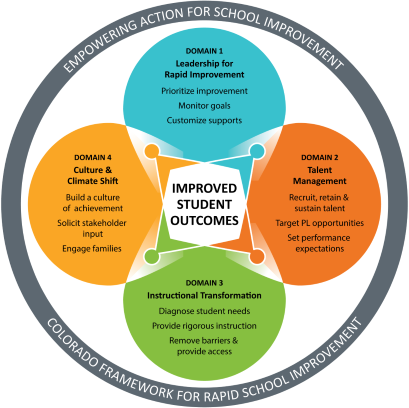You are here
Family-School-Community Partnerships (FSCP) Strategy Guide v1
Introduction of Strategy
The Colorado Department of Education, in collaboration with teachers, families, district leaders, and community members, defines family-school-community partnerships (FSCP) as families, early childhood programs, schools, and communities actively partnering to develop, implement, and evaluate effective and equitable practices to improve educational outcomes for children and youth. Effective family engagement contributes to improved student outcomes and to closing persistent achievement gaps among students of different racial and ethnic backgrounds and family income levels. Additionally, experts advocate for family engagement as an essential element of building the pathway to college and career readiness for all students, and a critical component of a systems approach to school turnaround.
Senate Bill 09-90 states that at the state level, Colorado shall align its FSCP work with the National Standards for Family-School Partnerships. These research-based standards are a way for schools to categorize their FSCP work to ensure they have a sustainable and comprehensive partnership structure that links to positive student outcomes. The National Standards for Family-School Partnerships are:
Evidence Base
ESSA defines levels of research based on the quality of the study (Levels 1-4). CDE requires that schools and districts identify the research base for strategies that they select for their Unified Improvement Plans, and for applications for school improvement funds in the EASI application.
-
The research on Family-School-Community Partnerships that is cited here meets the definition of Level 1 research. The research cited focused on the impact on changing district and school practices when all Family-School-Community Partnerships components were implemented. In addition, substantial research meeting levels 1-4 have been completed; they found that when implemented to a high level, Family-School-Community Partnerships had an impact on a schools' instructional practices and student achievement.
Academic Studies Leading to ESSA Rating
Angell, S. R., Bass, H. P., Meisinger, R. E., Marcus, M. J., & Sheridan, S. M. (2016). Achieving academic success for your student through family school partnerships: A TAPP research brief. Nebraska Center for Research on Children, Youth, Families and Schools.
Bryk, A. S. (2010). Organizing schools for improvement. Phi Delta Kappan, 91(7), 23-30.
Epstein, J. L. (2010). School/family/community partnerships: Caring for the children we share. Phi Delta Kappan, 92(3), 81-96.
Hoover-Dempsey, K. V., Walker, J. M., Sandler, H. M., Whetsel, D., Green, C. L., Wilkins, A. S., & Closson, K. (2005). Why do parents become involved? Research findings and implications. The elementary school journal, 106(2), 105-130.
Mapp, K., & Kuttner, P. (2013). Partners in education: A dual-capacity building framework for family-school partnerships. Austin, TX: Southwest Educational Development Laboratory.
Patrikakou, E. N. (2016). Contexts of family–school partnerships: A synthesis. In Family-school partnerships in context (pp. 109-120). Springer, Cham.
Sheldon, S. B., & Jung, S. B. (2018). Student outcomes and parent teacher home visits. Center on School, Family, & Community Partnerships, Johns Hopkins University. Recuperado de http://www.pthvp.org/wp-content/uploads/2018/12/181130-StudentOutcomesandPTHVReportFINAL.pdf.
Van Voorhis, F. L. (2011). Adding families to the homework equation: A longitudinal study of mathematics achievement. Education and Urban Society, 43(3), 313-338.
Considerations
Possible Root Causes include inadequate, inconsistent or ineffective...
- Attendance and Engagement systems
- Family engagement
- School culture
- Student experiences
- Student mobility
Is this strategy a good fit for your district/school?
- Does this major improvement strategy focus on a priority performance challenge and associated root cause(s)?
- Are the expected outcomes of this major improvement strategy highly valued?
- Do key leaders support this major improvement strategy? Do key leaders have the capacity to lead the strategy ongoing?
- What are the skills and competencies needed to implement this major improvement strategy with fidelity? What support/professional development do staff members need to implement this strategy effectively?
- Are the time, effort and resources needed for implementation feasible for the staff involved?
Considerations for Strategy Implementation
- How are your practices inclusive of all families?
- How are you learning about families' lived experiences?
- Who is leading and supporting the creation of the welcoming culture?,
- What do trusting relationships look like in your program/district/school?
- How are you ensuring effective use of two-way communication with your families to sustain positive relationships?
- How do you leverage relationships with families to achieve your program/district/school goals?
- How do you use the context expertise of families to better your content expertise?
- How are you utilizing the assets of your families in your program/schools?
- How are you using FSCP as a school improvement strategy?
- How do you implement evidence-based practices to cultivate and sustain FSCP?
- Where are you now and where will you go?
- How will you continually improve your family partnerships through community-based resources?
Implementation Guide:
Information coming soon
Information coming soon
Information coming soon
Information coming soon




Connect With Us





